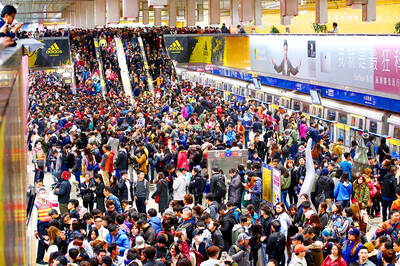The New Power Party (NPP) yesterday criticized an administrative investigation by the Ministry of Transportation and Communications into a deadly derailment in April, saying the probe failed to hold the Taiwan Railways Administration (TRA) to account for its “negligence” in ensuring the safety of the railway service.
The Taroko Express No. 408 on April 2 derailed in the Cingshuei Tunnel (清水隧道) after slamming into a crane truck that had slid onto the tracks, killing 49 people and injuring 245.
The crane truck was owned by a contractor hired by the TRA for construction to stabilize slopes along the railway line.
While the Taiwan Transportation Safety Board is in charge of investigating the causes of the crash, the ministry investigated the TRA for officials who should be held accountable. The ministry published its report on Sunday.
The administrative investigation should have probed United Geotech Inc and whether it had fulfilled its responsibility of overseeing construction work based on its contract with the TRA, NPP caucus whip Chiu Hsien-chih (邱顯智) said.
However, the TRA has said that United Geotech participated in the investigation as well, he said.
“What role did Geotech play in the investigation? Was it both the player and referee? The railway agency should offer a clear explanation to the public,” he said.
The report points to problems with the contractor, but does not mention any mistakes by the TRA, Chiu said, adding that this shows that the railway agency avoided the truth and has no intention of improving railway safety.
NPP deputy caucus whip Chen Jiau-hua (陳椒華) said the incident exposed the TRA’s “business as usual” attitude: blaming ground-level workers whenever accidents happen and having no intention of pursuing meaningful reform.
However, the report shows that a ministry task force had found in multiple on-site inspections that construction sites 2m above the railway track lacked guard rails, Chen said, but the TRA’s construction crew in Hualien left the issue unresolved.
Following the derailment of a Puyuma Express train in 2018, the Executive Yuan conducted a comprehensive review of the TRA’s operations and listed 144 issues that had to be addressed, Chen said.
One of the issues was to enhance safety along railway sections where there is ongoing construction nearby, but the ministry on March 16 last year removed the item from a list of closely monitored issues, Chen said.
If the ministry had regularly checked the TRA’s progress in addressing these issues, the Taroko Express crash would not have occurred, she said.
“After the Taroko Express incident, the TRA’s construction division chief in Hualien was given a major demerit. However, then-TRA deputy director general Du Wei (杜微) was promoted to director rather than being demoted. The Railway Bureau, which oversees the TRA’s operations, was not blamed for that incident either,” she said.
“This shows that senior officials at the ministry, the Railway Bureau and the TRA neither took full responsibility for what happened nor did they review root causes of the incident,” she added.
Wang Wei-chun (王薇君), who represents family members of people who died in the Taroko Express derailment, said that although the report was compiled on May 21, the families found out about it through media reports.
The ministry should have notified the deceased’s next of kin about the report first, she said.
“To them [ministry officials], 49 is nothing but a number,” she said.
On Monday, some relatives of the victims went to the ministry to submit a petition, but they were blocked by police, Wang said.

People can take the Taipei MRT free of charge if they access it at Nanjing Sanmin Station or Taipei Arena Station on the Green Line between 12am and 6am on Jan. 1, the Taipei Department of Transportation said on Friday, outlining its plans to ease crowding during New Year’s events in the capital. More than 200,000 people are expected to attend New Year’s Eve events in Taipei, with singer A-mei (張惠妹) performing at the Taipei Dome and the city government’s New Year’s Eve party at Taipei City Hall Plaza, the department said. As people have tended to use the MRT’s Blue or

Civil society groups yesterday protested outside the Legislative Yuan, decrying Chinese Nationalist Party (KMT) efforts to pass three major bills that they said would seriously harm Taiwan’s democracy, and called to oust KMT caucus whip Fu Kun-chi (傅?萁). It was the second night of the three-day “Bluebird wintertime action” protests in Taipei, with organizers announcing that 8,000 people attended. Organized by Taiwan Citizen Front, the Economic Democracy Union (EDU) and a coalition of civil groups, about 6,000 people began a demonstration in front of KMT party headquarters in Taipei on Wednesday, organizers said. For the third day, the organizers asked people to assemble

Taipei is participating in Osaka’s Festival of Lights this year, with a 3m-tall bubble tea light installation symbolizing Taiwan’s bubble tea culture. The installation is designed as a bubble tea cup and features illustrations of Taipei’s iconic landmarks, such as Taipei 101, the Red House and North Gate, as well as soup dumplings and the matchmaking deity the Old Man Under the Moon (月下老人), affectionately known as Yue Lao (月老). Taipei and Osaka have collaborated closely on tourism and culture since Taipei first participated in the festival in 2018, the Taipei City Department of Information and Tourism said. In February, Osaka represented

Taiwanese professional baseball should update sports stadiums and boost engagement to enhance fans’ experience, Chinese Professional Baseball League (CPBL) commissioner Tsai Chi-chang (蔡其昌) told the Liberty Times (sister paper of the Taipei Times) in an interview on Friday. The league has urged Farglory Group and the Taipei City Government to improve the Taipei Dome’s outdated equipment, including relatively rudimentary television and sound systems, and poor technology, he said. The Tokyo Dome has markedly better television and sound systems, despite being 30 years old, because its managers continually upgraded its equipment, Tsai said. In contrast, the Taipei Dome lacked even a room for referees